
in-flight with Air-Niugini




Winner, 1989 PATAGold Award Be for best Travel Story. : ' .
Welcome aboard,
The gold rush at Mt Kare is one of many that have shaped the history of Papua New Guinea in the 20th Century, fulfilling ancient myths of an 'island of gold' in the southern seas.
Growing international acclaim for the nation's artists makes the annual art and crafts exhibition, held annually during Independence celebrations, a must for exhibitors and visitors.
The Sepik River and the surrounding countryside yield a wide variety of foodstuffs that are used to create a rich, traditional cuisine.
Come with us and get a taste of this beautiful country and enjoy your flight.

Dieter Seefeld
Chief Executive AirNiugini
Annual arcs and crafts
Mc Kare gold rush is one of many this century.
PN
Images of Pore Moresby stir memory of former
Character
On
Rich
Cover: 'Gekou', an ink drawing by Jakupa. Photograph by Liz Thompson
No 76 Sept - Oct 1989
Paradiseis published bi-monthly by Air Niugini, PO Box 7186, Boroko, Papua ew Guinea (telephone 273415; telex NE22225).
Dieter Seefeld Chief Executive Air Niugini •
Editor - Geoff McLaughlin MBE
Consultant - Bob Talbot
Editorial - Ross Waby ubscriptions - Maggie Worri
Advertising Papua New Guinea - cl- The Editor, Paradise Magazine, P.O. Box 7186, Boroko.
Australia- Samuelson Talbot & Partners Pty. Ltd. 236 Dorcas Street, South Melbourne 3205. Telephone Melbourne (03) 699 8677
Subscriptions
Annual subscription rates for six issues are: USA,Europe, UK and Africa Kina 23 (US$28)
Australia,New Zealand, Asia and South Pacific Kl9 (USS24, A$25) Papua New Guinea Kl3 payment by international bank draft.
Printed in Singapore by Times Publishing Group.
No
Out here you can't afford to use anything but Mobil
When you have expensive machines working in the world's toughest terrain you can't take chances with your lubricant. You need an oil you can rely on. Ordinary oils can break down under severe engine conditions.
Mobil synthetic lubricants can keep equipment running at much greater speeds, under heavier loads and at higher temperatures. By lasting longer, they reduce maintenance and downtime, making your machines far more

productive. Can you afford not to use Mobil synthetic Oils? For more information please call Port Moresby Tel: 21 7177 or Lae Tel: 421444.
Story and photographs
by Liz Thompson

Port Moresby comes alive in mid-September with Independence celebrations but Independence is not the only cause for celebration. The W aigani Arts Centre also erupts with color and vitality as it houses another annual Papua New Guinean Arts and Crafts Exhibition. The 1988 .exhibition involved 100 exhibitors and more than 600 pieces of art. Quality is monitored to a certain extent but the objective is to provide a place for up-and-coming artists as well as those already internationally acknowledged; a formula which produces an interesting diversity.
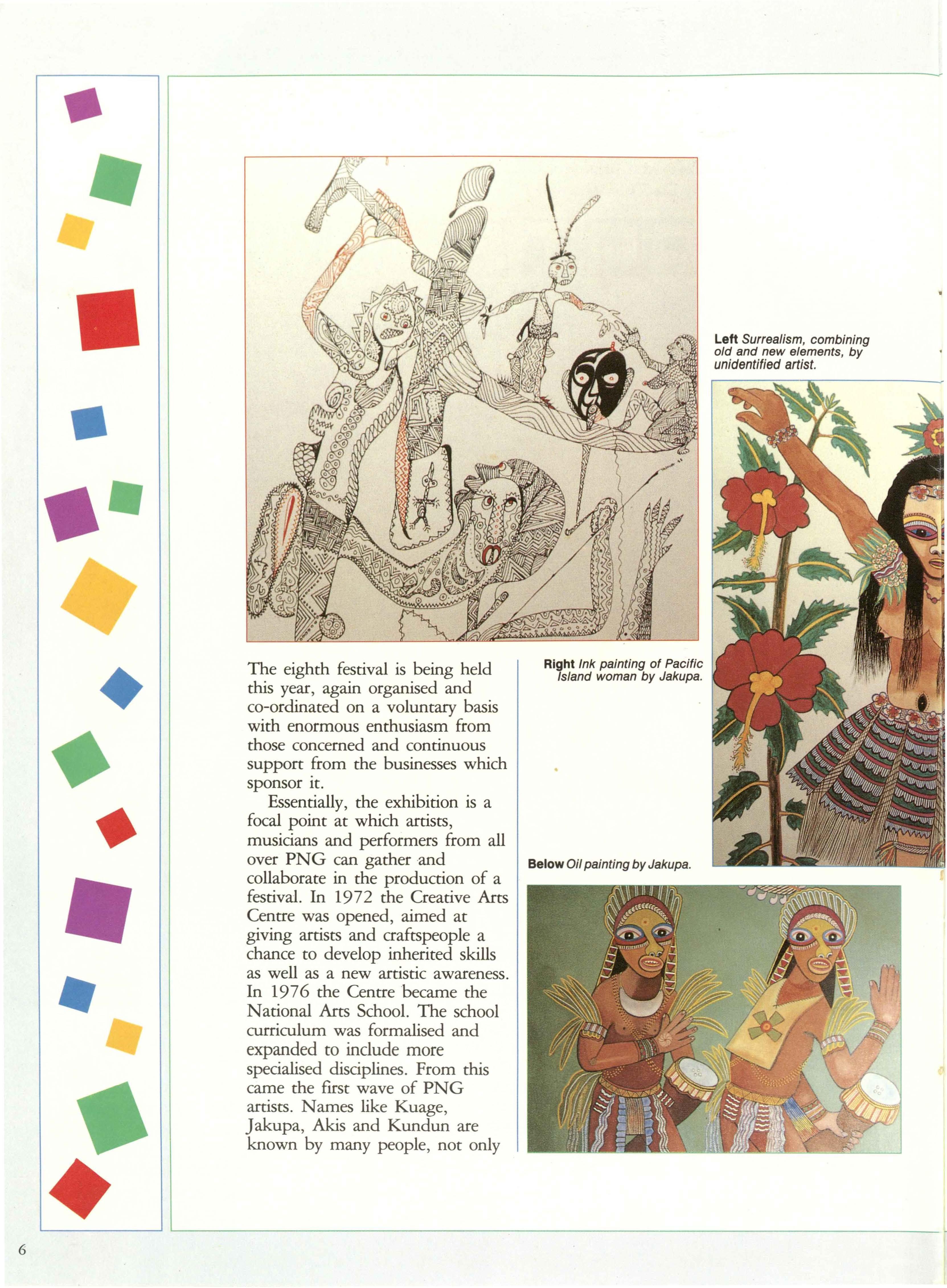
The eighth festival is being held this year, again organised and co-ordinated on a voluntary basis with enormous enthusiasm from those concerned and continuous support from the businesses which sponsor 1t.
Essentially, the exhibition is a focal point at which artists, musicians and performers from all over PN G can gather ·and collaborate in the production of a festival. In 1972 the Creative Arts Centre was opened, aimed at giving artists and craftspeople a chance to develop inherited skills as well as a new artistic awareness. In 19 7 6 the Centre became the National Arts School. The school curriculum was formalised and expanded to include more specialised disciplines. From this came the first wave of PNG artists. Names like Kuage, J akupa, Akis and Kundun are known by many people, not only
in PNG but overseas. As Dominique Martin, the Arts and Crafts exhibition co-ordinator points out: "Some, like Kuage, came from places where art was almost non-existent and he had only his imagination, his folk tales and legend as baggage. As well as developing old skills they were exposed to new mediums and new • techniques which enabled them to open the path for original modern, PN G art with its own identity, taking roots in the old traditions

and depicting, often with humor, their fast developing country."
All talented artists in their own right, they gained exposure, primarily because of their talent but also because of the novelty of their position._,They were really the first artists to be recognised as representative of a contemporary artistic tradition in PNG. After the first wave of new artists there will be more who also will need public recognition and enthusiasm for their work. As well as the novelty there is without doubt talent and in order to encourage its development young PNG artists need a place where their work can be shown and appreciated; the Art and Crafts exhibition provides just such a place.
One week before the opening, artists gather, presenting their work to the organisers. Schools and colleges are encouraged to


enter collective displays. Mediums include drawing, photography, macrame, metalwork, copper beating and leather work. Carvings, paintings, sculptures, bilums, cups, pots and jewellery appear, filling every available space. Walls are covered with pictures, textiles and graphics; platforms and tables are covered with crafts; the spaces in between are filled with creative energy. In the sunny courtyard craftspeople demonstrate their skills so that people can learn as well as look.
Performers in theatre, music and dance are welcomed from all nationalities in PNG. The 1988 exhibition featured Scottish dancers and a choreographed traditional dance by the Siale School of Dance. Opening night speeches were brief and entertainment was abundant. Piped music, Asian dancing, the National Theatre company, choirs and singsing groups all featured. In 1989, Maoris, other Pacific Islands people and PNG dance schools, among others, are expected to

perform. In the same way that arts and crafts are progressing, the exhibition hopes to involve all forms of the arts. The presence of dance, live music and performance throughout the event bears witness to this.
An exhibition of this nature provides a rare opportunity for the public, residents and tourists to keep in touch with PN G's contemporary art. scene and to support it. Many of the works are for sale, with 15 per cent of the revenue going to the Arts Council as a contribution to the cost of the venture. Those fortunate enough to be in Port Moresby on Independence Weekend can support the growing number of contemporary artists. As one critic noted: "There is a tendency to emphasise the preservation of PNG culture, as if like Latin it had a formal beginning and end. The Arts Council exhibition reveals just how vital and energetic contemporary culture is in this country." It is, without doubt, worth a visit.


The Papua New Guinea Banking Corporation is the only bank to provide banking services at Jackson's Airport in Port Moresby, for the benefit of international travellers.
And as you'd expect from PNG's 11nambawan 11 bank, you'll find our many branches and
agencies right around the country, no matter where you go.
So whatever your personal or business banking needs, it pays to deal with the friendly staff at the PNGBC.
We're the bank that really knows PNG best.


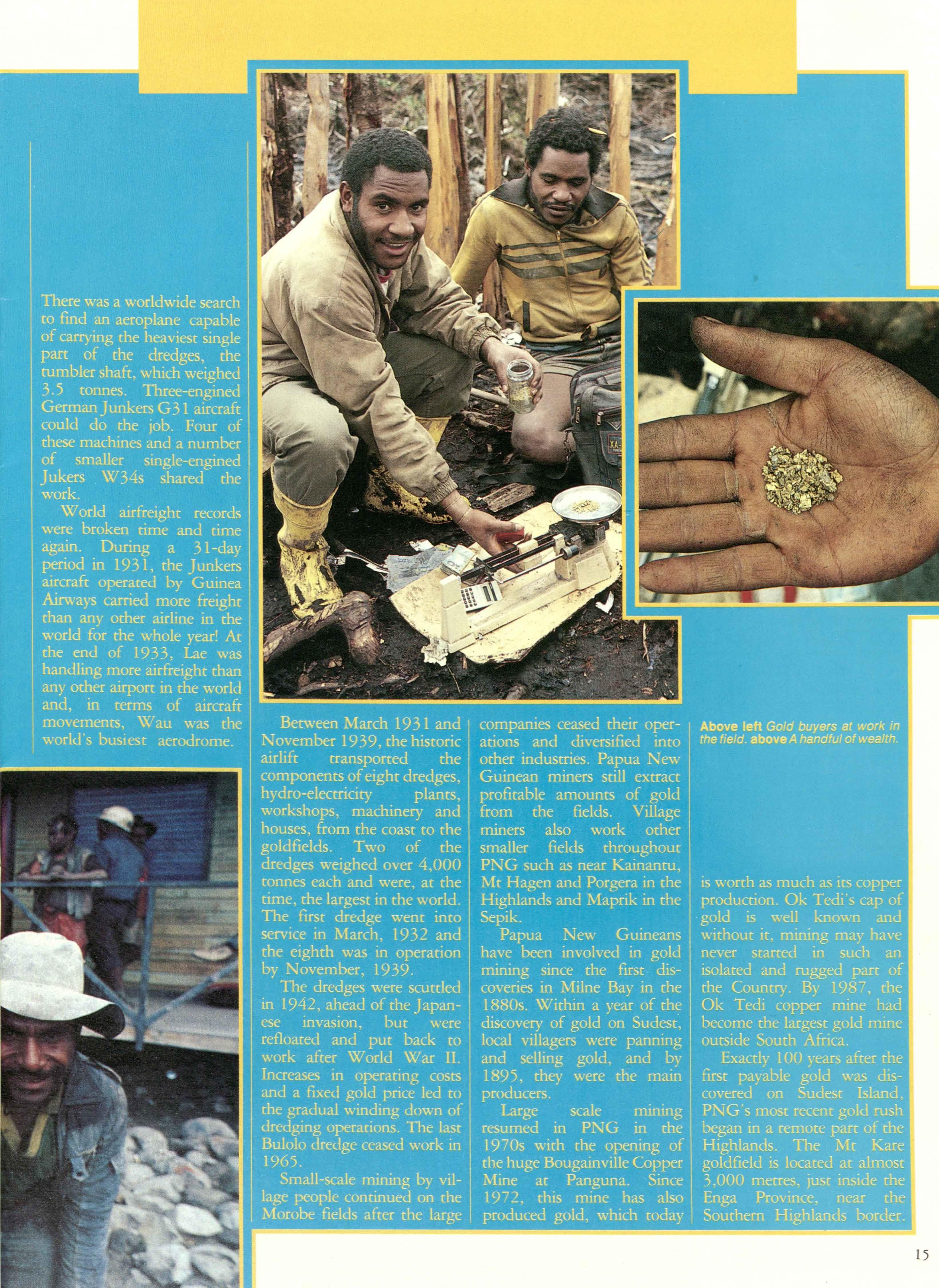

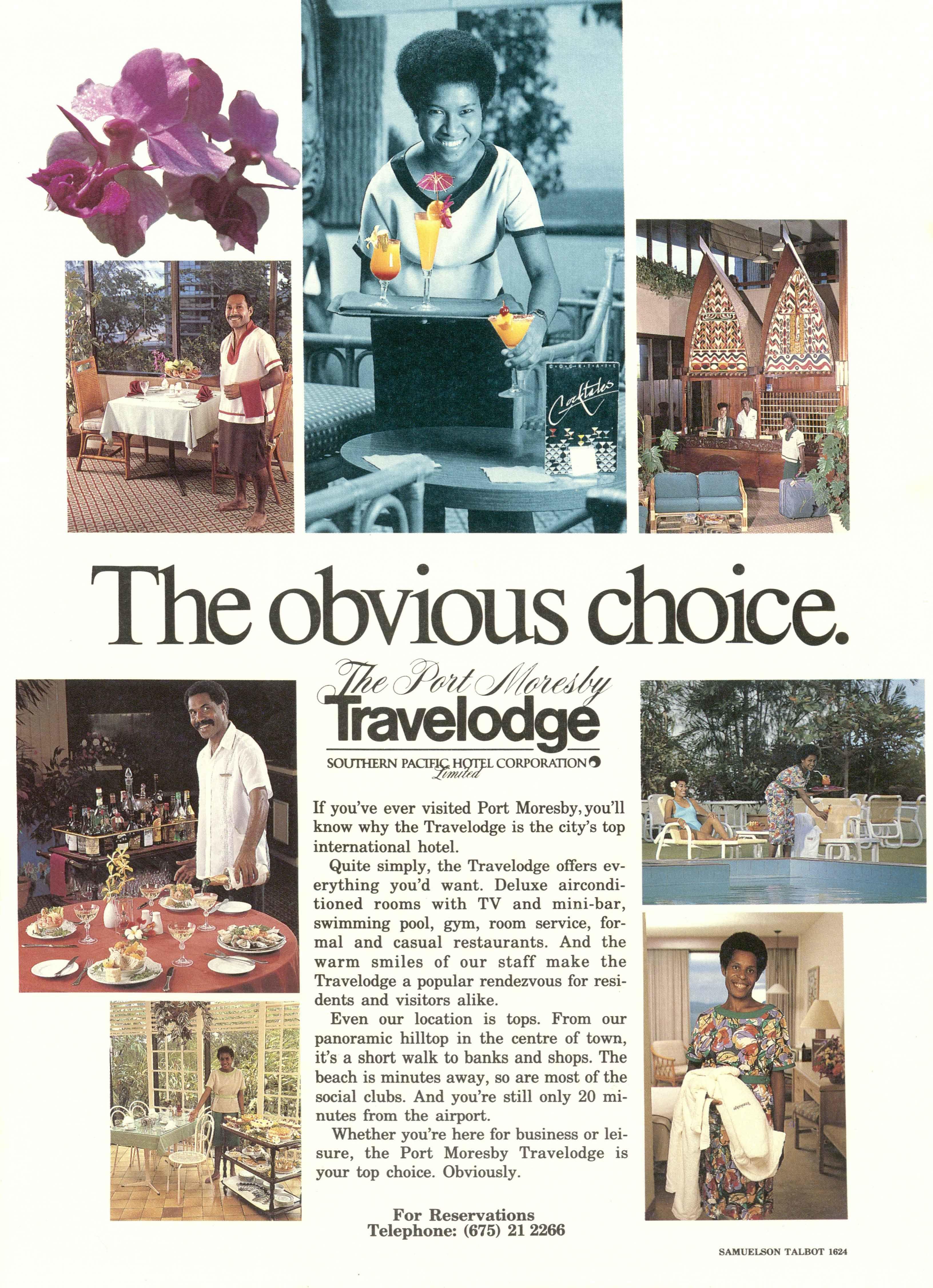
If you've ever visited Port Moresby, you'll know why the Travelodge is the city's top international hotel.
Quite simply, the Travelodge offers everything you'd want. Deluxe airconditioned rooms with TV and mini-bar, swimming pool, gym, room service, formal and casual restaurants. And the warm smiles of our staff make the Travelodge a popular rendezvous for residents and visitors alike.
Even our location is tops. From our panoramic hilltop in the centre of town, it's a short walk to banks and shops. The - beach is minutes away, so are most of the social clubs. And you're still only 20 minutes from the airport.
Whether you're here for business or leisure, the Port Moresby Travelodge 1s your top choice. Obviously.
For Reservations Telephone: (675) 212266

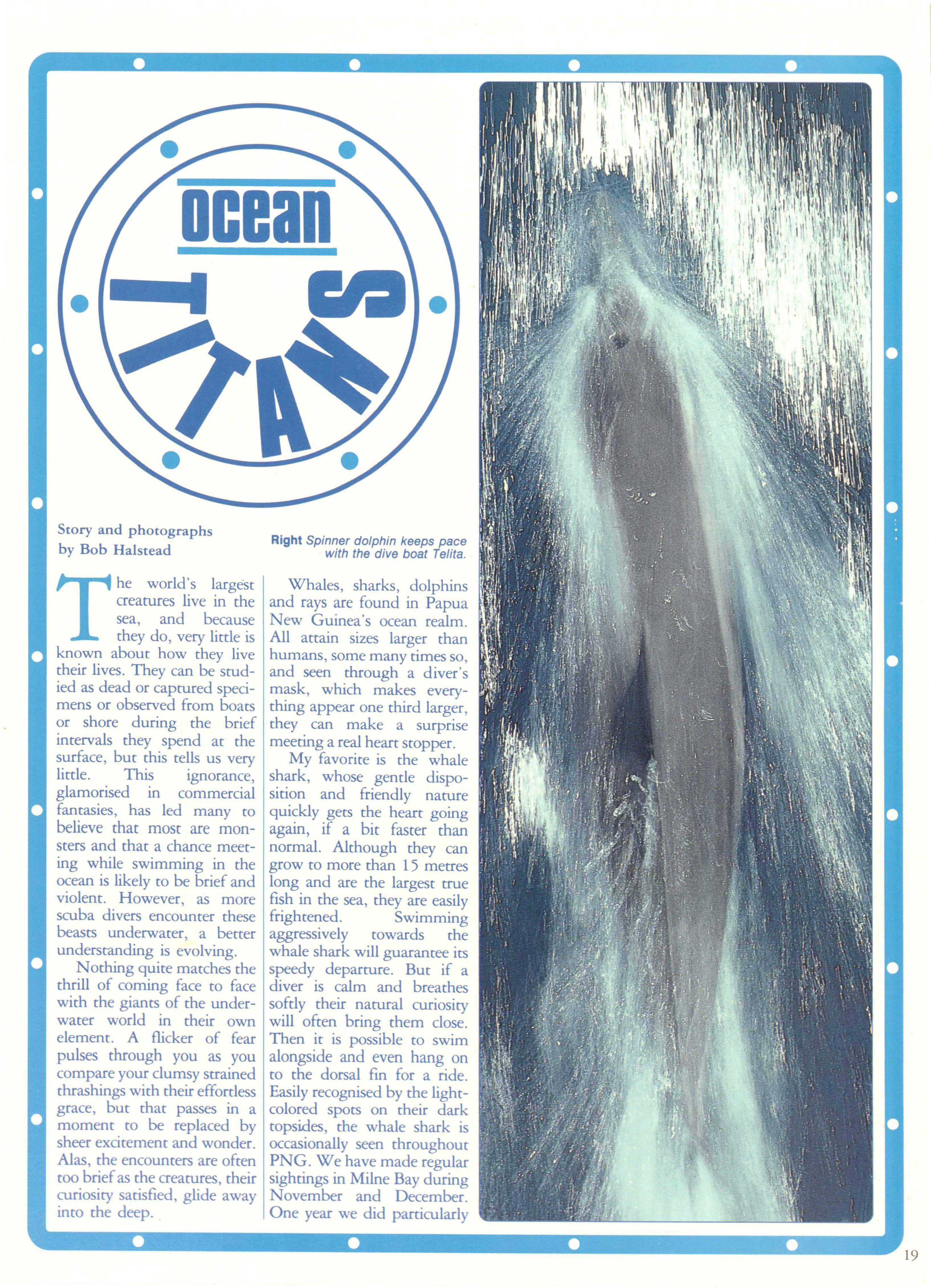
••Story
and photographs
by Bob Halstead
The world's largest creatures live in the sea, and because they do, very little is known about how they live their lives. They can be studied as dead or captured specimens or observed from boats or shore during the brief intervals they spend at the surface, but this tells us very little. This ignorance, glamorised in commercial fantasies, has led many to believe that most are monsters and that a chance meeting while swimming in the ocean is likely to be brief and violent. However, as more scuba divers encounter these beasts underwater, a better understanding is evolving. Nothing quite matches the thrill of coming face to face with the giants of the underwater world in their own element. A flicker of fear pulses through you as you compare your clumsy strained thrashings with their effortless grace, but that passes in a moment to be replaced by sheer excitement and wonder. Alas, the encounters are often too brief as the creatures, their curiosity satisfied, glide away into the deep ..
Whales, sharks, dolphins and rays are found in Papua New Guinea's ocean realm. All attain sizes larger than humans, some many times so, and seen through a diver's mask, which makes everything appear one third larger, they can make a surprise meeting a real heart stopper.
My favorite is the whale shark, whose gentle disposition and friendly nature quickly gets the heart going again, if a bit faster than normal. Although they can grow to more than 15 metres long and are the largest true fish in the sea, they are easily frightened. Swimming aggressively towards the whale shark will guarantee its speedy departure. But if a diver is calm and breathes softly their natural curiosity will often bring them close. Then it is possible to swim alongside and even hang on to the dorsal fin for a ride. Easily recognised by the lightcolored spots on their dark topsides, the whale shark is occasionally seen throughout PNG. We have made regular sightings in Milne Bay during November and December. One year we did particularly

well, meeting whale sharks on four consecutive Telita cruises. For Joan Taureka of Pon Moresby it was her first time co dive with any shark. Some people start at the cop!
Killer whales, or orca, are also seen. Most people associate these animals with cold water but they are regular visitors co the tropics. The enormous dorsal fin on the male adult, spearing out of the water as it rises co breathe, makes immediate identification obvious. The first one we swam with, again in Milne Bay, had killed an ocean sunfish (mola mola) and was eating it. He would drop the fish, swim under us as we snorkelled on the surface, giving us a good look by turning on his side, then swim back co recover his meal before it sank coo far. Lacer we saw a complete family with mother, father and two young whales and we have had several encounters since. The killer whale has a reputation for aggressive behavior and early diving manuals advised praying as the only, and last, aaion co cake if you were unfortunate enough co meet one underwater. Our experience has shown them co be playful and gentle with humans though there is no doubt that they are a supreme predator and could easily kill us if they wished. I just do not think we are on their menu.
Dolphins are abundant in our waters, particularly the spinner dolphin that loves to give dramatic demonstrations of its prowess as it makes giant leaps, spinning crazily before it splashes dow_n and
races to ride Telica's bow wave. This is quite a spectacle for our guests, but at night it is even more so as the glowing phosphorescence of the water trails their sparkling luminous bodies which surge, leap and dash across Telita's bow.
Unfortunately these beautiful animals are very shy in the water and usually do not let divers approach too closely.
Pilot whales and some of the largest whales are also difficult, but not impossible, co swim with underwater.
One of my most thrilling encounters occurred on a Telita cruise nonh of New Britain. We had already experienced some outstanding reef dives and were moving through the Bali Viru group of Islands when whales were sighted. We managed to get quite dose and the whales
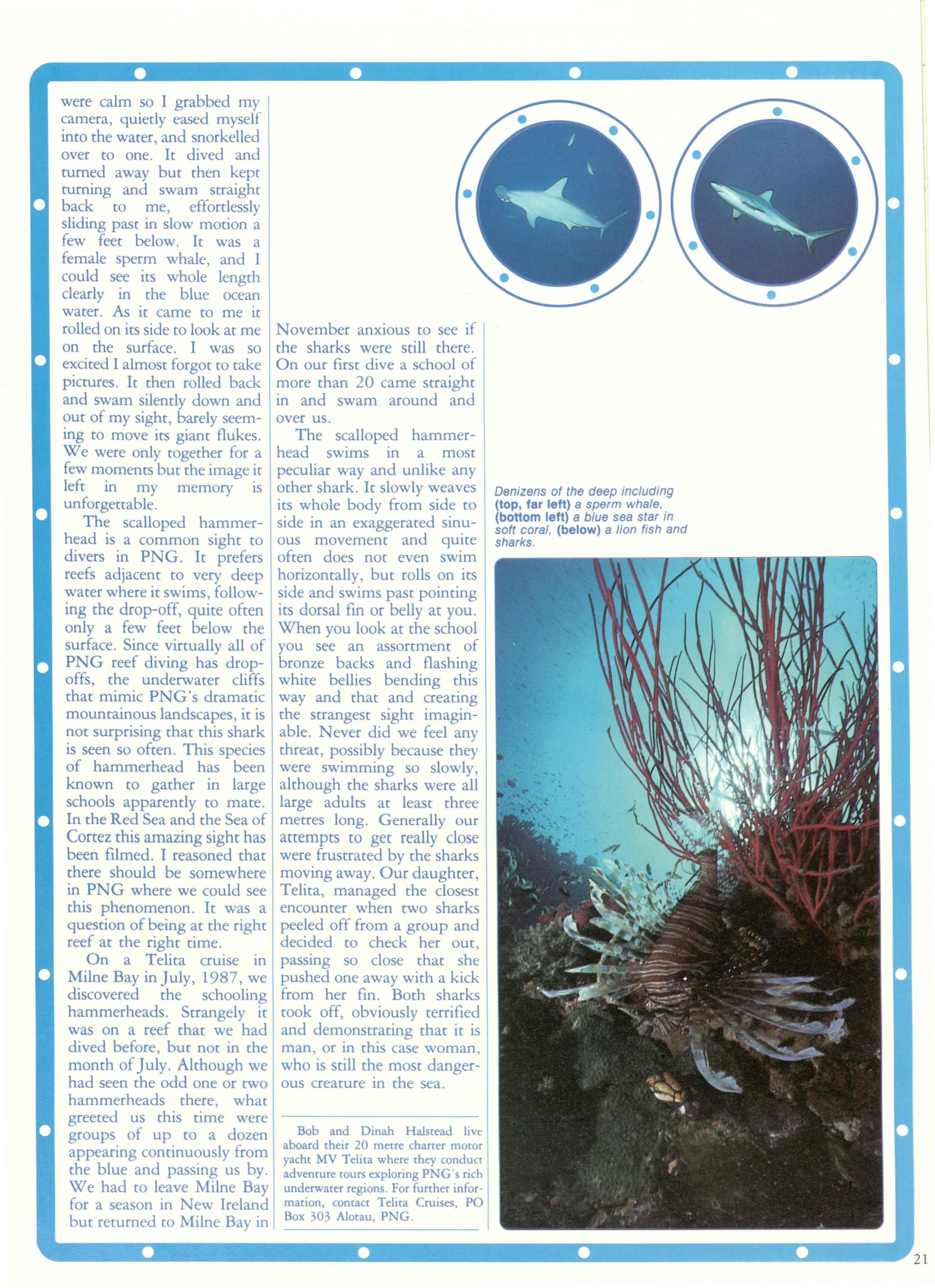
were calm so I grabbed my camera, quietly eased myself into the water, and snorkelled over to one. It dived and turned away but then kept turning and swam straight back to me, effortlessly sliding past in slow motion a few feet below. It was a female sperm whale, and I could see its whole length clearly in the blue ocean water. As it came to me it rolled on its side co look at me on the surface. I was so excited I almost forgot to take pictures. It then rolled back and swam silently down and out of my sight, barely seeming to move its giant flukes. We were only together for a few moments but the image it left in my memory is unforgettable.
The scalloped hammerhead is a common sight to divers in PNG. It prefers reefs adjacent co very deep water where it swims, following the drop-off, quite often only a few feet below the surface. Since virtually all of PN G reef diving has dropoffs, the underwater cliffs that mimic PN G's dramatic mountainous landscapes, it is not surprising that this shark is seen so often. This species of hammerhead has been known to gather in large schools apparently to mate. In the Red Sea and the Sea of Cortez this amazing sight has been filmed. I reasoned that there should be somewhere in PNG where we could see this phenomenon. It was a question of being at the right reef at the right time.
On a Telita cruise in Milne Bay in July, 1987, we discovered the schooling hammerheads. Strangely it was on a reef that we had dived before, but not in the month of July. Although we had seen the odd one or two hammerheads there, what greeted us this time were groups of up to a dozen appearing continuously from the blue and passing us by. We had to leave Milne Bay for a season in New Ireland but returned to Milne Bay in
November anxious co see if the sharks were still there. On our first dive a school of more than 20 came straight in and swam around and over us.
The scalloped hammerhead swims in a most peculiar way and unlike any other shark. It slowly weaves its whole body from side to side in an exaggerated sinuous movement and quite often does not even swim horizontally, but rolls on its side and swims past pointing its dorsal fin or belly at you. When you look at the school you see an assortment of bronze backs and flashing white bellies bending this way and that and creating the strangest sight imaginable. Never did we feel any threat, possibly because they were swimming so slowly, although the sharks were all large adults at least three metres long. Generally our attempts to get really close were frustrated by the sharks moving away. Our daughter, Telita, managed the closest encounter when two sharks peeled off from a group and decided to check her out, passing so close that she pushed one away with a kick from her fin. Both sharks cook off, obviously terrified and demonstrating that it is man, or in this case woman, who is still the most dangerous creature in the sea.
Bob and Dinah Halstead live aboard their 20 metre charter motor yacht MV Telita where they conduct adventure tours exploring PNG's rich underwater regions. For further information, contaa T elita Cruises, PO Box 303 Alotau, PNG.
Denizens of the deep including (top, far left) a sperm whale, (bottom left) a blue sea star in soft coral, (below) a lion fish and sharks.


Mike Fa'atoiahas never been to sea but he knowsthe Pacific like the back of his hand.
TogetherwHhtherest of the teamat PacjficForum£jne,Mjkemakessure yourproductsare dejjveredjn good condjUon,and on Ume.
Cyclonesandhurrjcanescan upset Mjke's efficjency.But eventhen,he usuallyhas an answeron hand.It's a b1gjob and veryfewpeopleknowthe Pacjflcqujteas wellas M1kedoes.He's conswntlyjn touchw1'ththe vessels,the marketsand yourneeds.
And thjs experjence js alwaysat your serv1ce.
We'reproud of Mjke and the rest of the teamat PacjfjcForum£jne,where your busjnesscomesfjrst and getsthere first, aroundthe Pac1fjc.
PacificForum Line ShippingServices
- Austrajja - AmericanSamoa
- ewZealand - Tuvalu
- Flji - Kiribati
- ew Caledonia - PapuaNewGuinea
- Tonga - SolomonIslands
- WesternSamoa - Cookislands
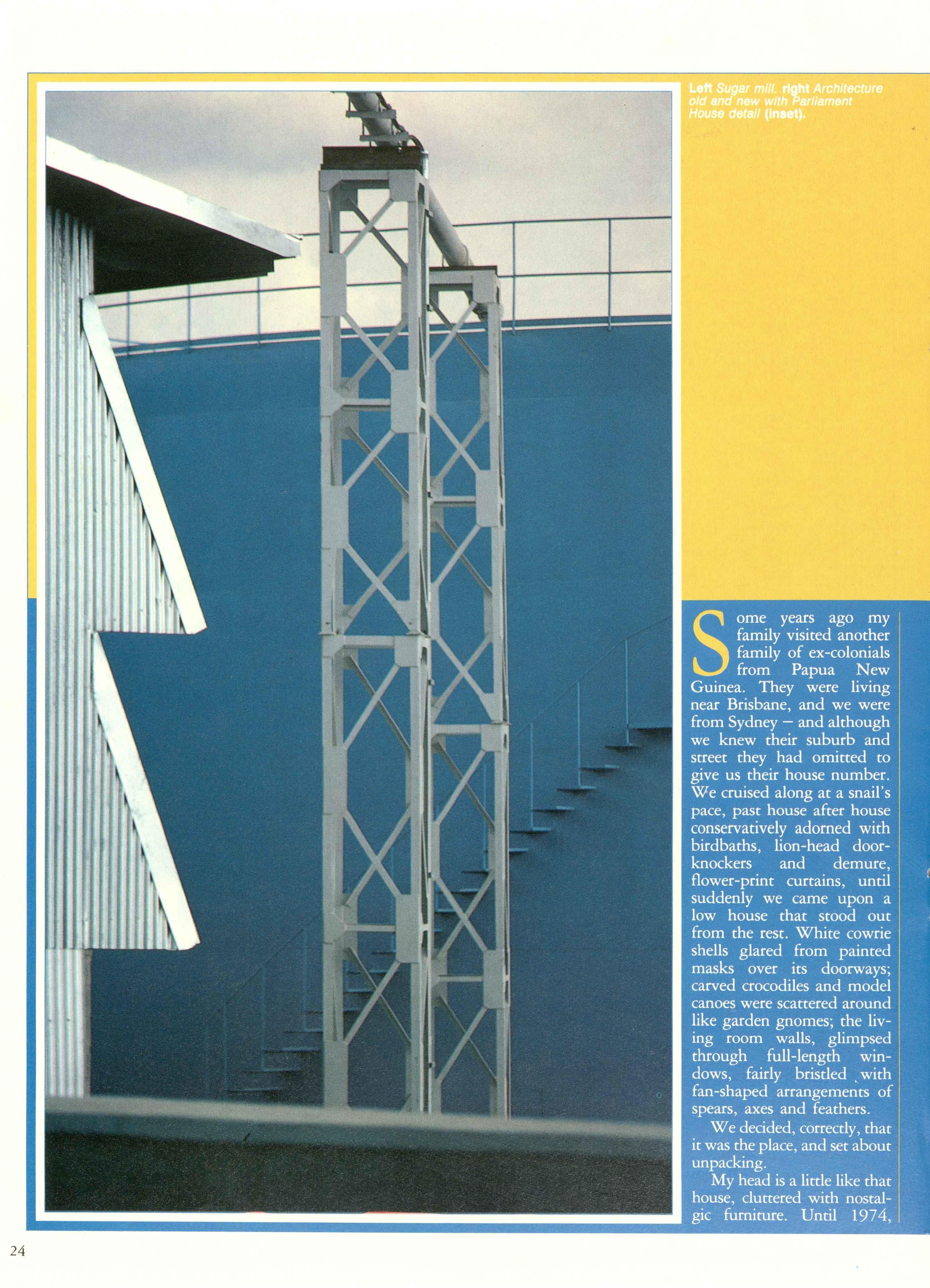

when I was 11 years old, my family spent most of its time in PN G, where my father had worked, first as a patrol officer in the Highlands and Trobriand Islands, then as a lecturer at Port Moresby's Administrative College. We left the country not long before it was granted Independence, settled in Sydney
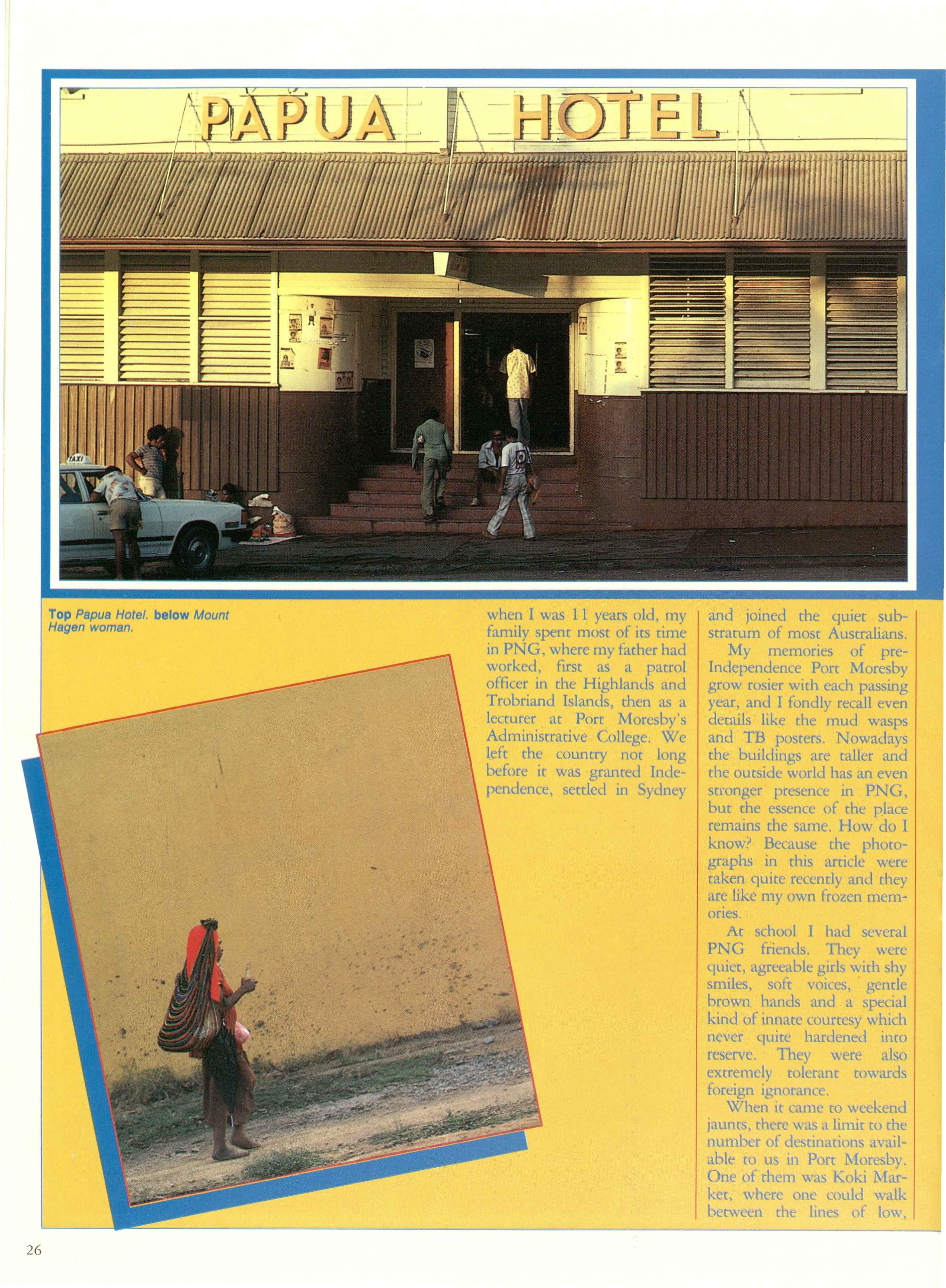
and joined the quiet substratum of most Australians.
!vfy memories of preIndependence Port Moresby grow rosier with each passing year, and I fondly recall even details like the mud wasps and TB posters. Nowadays the buildings are taller and the outside world has an even strnnger presence in PN G, but the essence of the place remains the same. How do I know? Because the photographs in this article were taken quite recently and they are like my mvn frozen men1ones.
At school I had several PNG friends. They were quiet, agreeable girls with shy smiles, soft voices, gentle brown hands and a special kind of innate courtesy which never quite lMrdened into reserve. The , were also extremely tolerant cowards foreign ignorance.
~r hen it ca1ne co \ ·eekend jaunts there •a· .i lin1it to the nun1ber of destin ttions available to us in P )rt ~{oresby. One of tl em \ ,as Koki !vfarket where me u uld ·walk between the lines ot lo"
palm-thatched stalls and select from a wide range of fish, fruit, nuts and vegetables laid out on coconut matting, hessian sacks or the bare dust.
Another weekend destination was Bomana War Cemetery, which we used as a picnic spot. It was a refreshing place. The lawns were always beautifully manicured, the hibiscus flowers were like jewels, the .glittering sprinklers danced in formation between immaculate, whiterthan-white headstones. Our other picnic spot was Tin Hat Creek. Here the allusion to war was not classical but romantic: a soldier's rusty helmet lay on the pebbles, with water rushing through a hole in its crown.
Port Moresby was full of comparable images. Car parks were planned around the horseshoe mounds that once concealed fighter planes beneath camouflage nets. The hull of the capsized ship J\1acDhui - a war casualtyd01ninated the harbor. Burned-out cockpits gently disintegrated in the bush around the airstrip and little
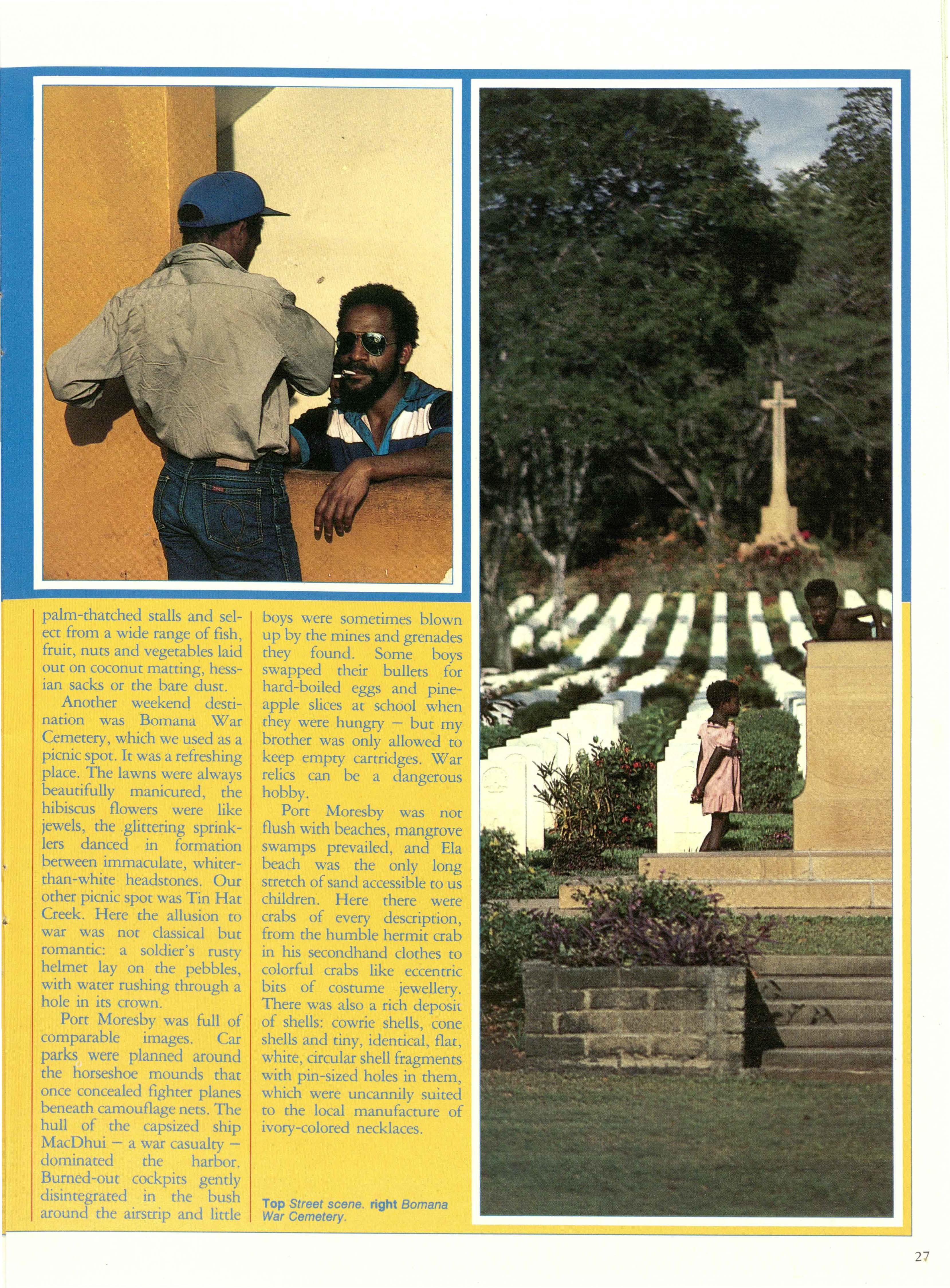
boys were sometimes blown up by the mines and grenades they found. Some boys swapped their bullets for hard-boiled eggs and pineapple slices at school when they were hungry - but my brother was only allowed to keep empty cartridges. War relics can be a dangerous hobby.
Port Moresby was not flush with beaches, mangrove swamps prevailed, and Ela beach was the only long stretch of sand accessible to us children. Here there were crabs of every description, from the humble hermit crab in his secondhand clothes to colorful crabs like eccentric bits of costume jewellery. There was also a rich deposit of shells: cowrie shells, cone shells and tiny, identical, flat, white, circular shell fragments with pin-sized holes in them, which were uncannily suited to the local manufacture of ivory-colored necklaces.
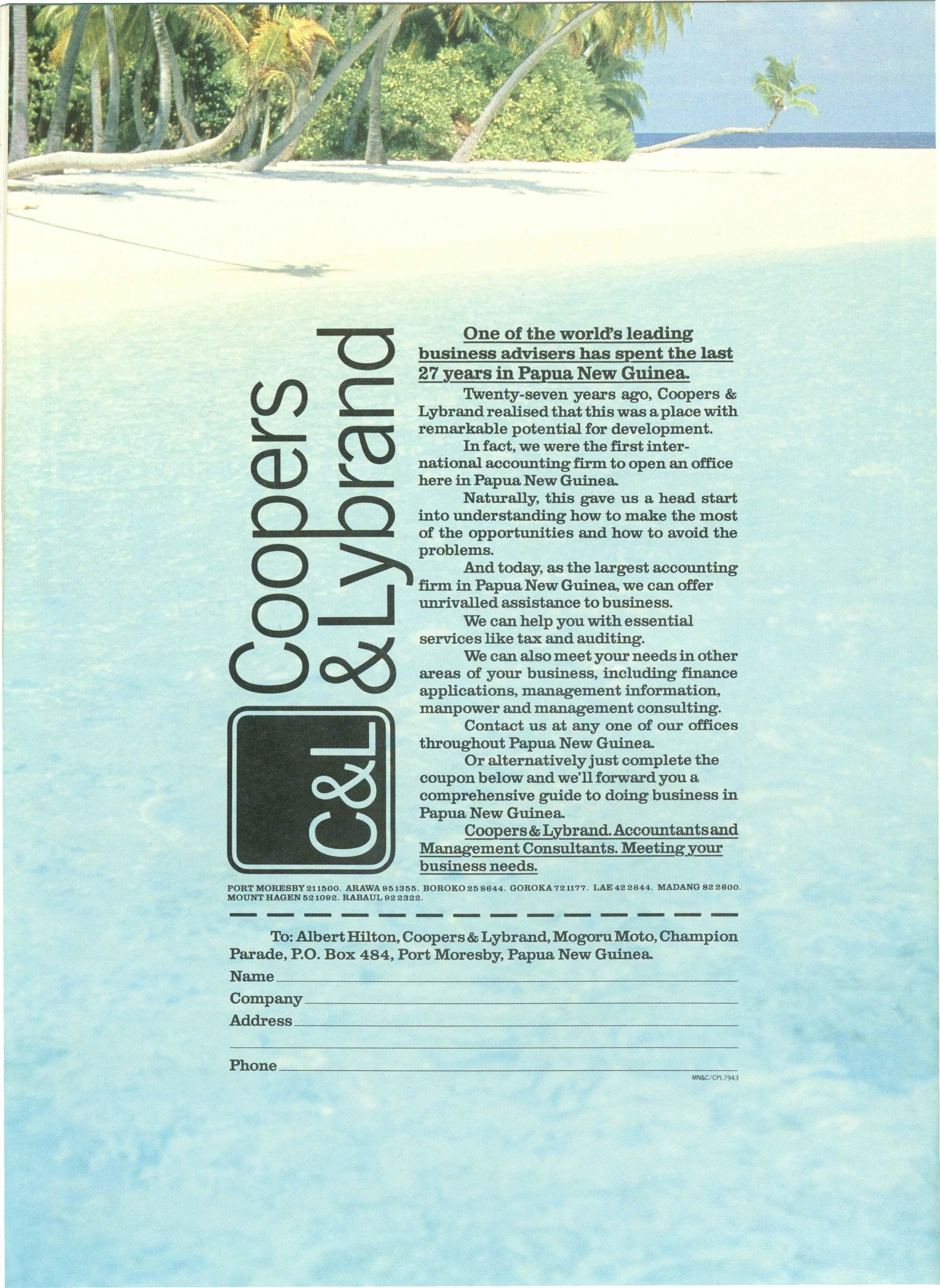
One of the world's leading business advisers has spent the last 27 )!'.earsin Papua New Guinea. , n C
'l\venty-seven years ago, Coopers & V / Lybrand realised that this was a place with ',, ro remarkable potential. for development.
In fact, we were the first inter,, \ \., national. accounting firm to open an office '-1.../ _ hereinPapuaNewGuinea. ~--.....
Naturally, this gave us a head start ( J ( J into understanding how to make the most - - of the opportunities and how to avoid the 0 >. problems.
And today, as the largest accounting ..:..Jfirm in Papua New Guinea, we can offer 0 unrivalled assistance to business.
We can help you with essential. services like tax and auditing.
We can al.so meet your needs in other areas of your business, including finance applications, management information, __J (.) manpower and management consulting. Contact us at any one of our offices throughout Papua New Guinea. Or alternatively just complete the coupon below and we'll forward you a comprehensive guide to doing business in Papua New Guinea. Coopers& Lybrand.Accountants and Management Consultants. Meet!!!g_xour business needs. PORTMORESBY211500. ARAWA951355. BOROKO258644. GOROKA721177. LAE422644. MADANG822600. MOUNT HAGEN 521092. RABAUL 92 2322.
To: Albert Hilton, Coopers& Lybrand, MogoruMoto, Champion Parade, P.O. Box 484, Port Moresby, Papua New Guinea. Nan1e


Americans and Australians are familiar with possums, or opossums as they are somenmes called, for these animals form an important part of the fauna of both continents. But despite the familiarity of possums, few visitors to Papua New Guinea realise that this country is home to the most spectacular array of possums to be found anywhere on earth. Indeed, the closest that many v1s1tors come to possums in PNG is the sight of aj piece of bright fur in a head-dress, or a tail hanging from some young dancer's neck.
Papua New Guineans know their possums as either Kapul in Tok Pisin, or cuscus in English, and although they might sometimes be hard to find, from PNG's farthest flung islands to its highest mountam tops, there are possums to suit every occasion. The great diversity and beauty of the possums of Australia and PNG have prompted Peter Schouten and myself to produce a fully illustrated book on these creatures. The drawings in this article are only some of the 60 or so that will appear in the final work, which will also include information on almost everything that one would want to know about these charming creatures.
PNG is home to the very largest as well as some of the smallest of possums. The world's largest possum species is unique to PNG, and is very rare. Known as the black-spotted cuscus, it can weigh up to seven kilograms and be almost a metre and a half in total length. It is found only in the undisturbed lowland jungles of northern PNG, and although it was first found in 1906 by a German explorer it is so rare that it has remained virtually unknown until very recently. Its obscurity was not helped when the original, and for a long time the only known specimen, was destroyed by
Sugar Glider
Coppery ringtail

the bombing of Vienna during W odd War II. Among the smaller of PNG's possums is the delightful sugar glider. This kitten-sized species (weighing about 100 grams) is widespread throughout most of Australia and PNG, including many offshore islands. Active by night, the sugar glider uses the- membranes of skin between its fore and hind legs to glide from one tree to the next. By day, up to a half dozen animals snuggle together in a tree hollow. Usually there is only one dominant male and his 'harem'. Sugar gliders eat a diverse range of foods. There are reports from Australia of groups of them attacking birds as large as guinea fowl. However, their more usual foods include sap and neaar. Despite the cuteness of this species, some Papua New Guineans regard them with dread. It is a common belief among the Goilala people of Central Province, for example, that sorcerers can transform themselves into sugar gliders, and travel by night to spy upon their enemies. The curious clicking call that this species sometimes makes is thus a cause for apprehension if one is hunting alone at night. . Perhaps the most unusual of PN G's possums are the so-called skunk possums. There are four species of skunk possums, all of which occur in PNG, so these animals can be thought of as truly unique PNG treasures. Anyone familiar with North American skunks would, if confronted with one of these creatures, see that they share many similarities with real skunks. For like true skunks the skunk possums are patterned boldly with black and white stripes. These colors are a warning sign in nature, and remarkably they warn of the same danger in both species. For the skunk possums, like true skunks, have glands around their anus that produce an evil smelling fluid.

When walking through PNG forests many people comment upon the distinctive, musky scent that emanates from some trees. Few, however, realise that the smell is the result of a skunk possum having been in the VlClnlty.
Skunk possums also have an unusual choice of food. One often sees old decayed logs in the forest that have been chewed and pockmarked all over. These logs are the feeding sites of skunk possums. By night the possums visit them, and listening carefully, locate the huge grub-like beetle larvae that bore through the rotting wood. Once a possum hears the jaws of the grub munching through wood, it uses its powerful front teeth to expose the larva. Then it brings in to play a most unusual mechanism. One fmger on each hand is longer and in some cases thinner than the rest. The possum uses it to fish for grubs. If the entire grub cannot .be easily extraaed by the teeth, the possum deftly inserts its long fmger and extracts it whole.
A fmal possum that merits a mention is the so called coppery ringtail of the high mountain forests. Visitors lucky enough to witness a traditional marriage in the highlands, or even to be staying in a village when a hunter returns, are likely to see this species, for it is one of the commonest varieties. During traditional marriages live posslims can form an important part of a bride price. The animals are located while they sleep by day in tree hollows, then brought out and either bound to poles or put in cages, and presented at the marriage ceremony. If you are lucky enough to witness such an event, check to see if the fur of the possums has a metallic lustre similar to burnished copper. If so, then the chances are that you are looking at a coppery ringtail.

Air Niugini knows there is no place for risks in aviation. Constantand dedicatedattention to quality and safety are the Shell contribution to our national airline's enviable safety record. That's why Shell is the major supplier of aviation fuels and lubricants to Air Niugini.
Each and every Shell employeecan be proud that in the past 1339days, not one hour due to accident has beenlost. The prior record stands at 1512days; ample proof that Shell cares about aviation safety.
At Dimet, we manufacture protective coatings. Because without our products thousands of multi-million dollar projects would have died an early death.
Tankers would have rusted. bridaes would have corroded, and all for ttie want of a few litres of the right kind of protection.
That's why it is our proud boast that Engineers and Architects world wide can trust Dimet when they think of protective coatings.
WE'VE BEEN SPECIALISTS FOR MORE THAN 40 YEARS.
After all, we invented the basis of the modern coatings industry back in 1936, when the world's first inorganic zinc silicate coating was developed in Melbourne.
Today it's franchised and exported to many countries in the world. We didn't stop at zinc silicate.

Our reputation as a high technology company continues to grow as we pioneer new developments in polyurethane, epoxy, elastomeric and other protective coatings. Our reputation is very important to us because our products are formulated to do their job of protection - long term.
And we take care that they do. And if we say that a Dimet product is right for the job, we want you to know that you can take the statement seriously.
Dimet products are exported to Papua New Guinea and the Pacific by:
INTERNATIONAL PlY. CTD. P.O.Box 912, Parramatta, NSW,Australia. Phone:(02)481 9399 Telex:AA25292 Fax: (02)481 9416
The Highlands of central Papua New Guinea, are a mountainous cordillera of parallel ranges running from north-west to south-east. Between these ranges exists a plateau, where hundreds of thousands of highlanders live in broad, fertile valleys. The highlanders have lived in these valleys for thousands of years, yet their existence was not known to the outside world until the early 1930s. It is this element of the unknown and the unfamiliar that enticed me to walk from the Highlands to the Sepik River. Our intended route to follow a sequence of trading routes, linking tribes, was mapped to take us ultimately to this great lowland river by the way of the Yuat River, one of its many tributaries.
My introduction to the highlands took place in Enga province, at the Kaiap Orchid Lodge. It was there that our group of six, three Australians, two Canadians and one American met for two days to make the final preparations for our trek.
Kaiap Lodge is on a high ridge between the Lai and the Amburn Valleys. Surrounding the building, are bountiful gardens of fresh vegetables, fruit and flowers. The Engans cultivate many crops such as taro, sugarcane and all kinds of green vegetables, often producing surplus crops which are sold to feed people in other parts of the country. Sam, a local Engan, our escort and interpreter for the twoweek trek, also operates a vegetable business.
Looking out over the Lai

Valley, we see amidst the deep green vegetation, welldefined lines of gardens neatly cut into the steep side hills. Wisps of smoke rising from many sources indicate that the population is spread out over the entire valley. The rugged environment, combined with the threat of attack from the unfriendly neighbors, have forced these Engans to live in small duster dwellings constructed at the vantage point best suited to spot unwelcome intruders.
The impact of tribal fighting becomes very real when Joe, a young Engan with whom we are walking, points out his father's grave site at the side of the road. Enemy tribes killed his mother and father a couple of years ago.
The divisions in these people's lives is evident as our walk continues. One moment Joe is talking about the mission school he attends and then he is discussing possible revenge for his parents' killers. We pass other Engans wearing traditional outfits of bark belts, cloth and leaves combined with modern t-shirts.
While sitting at 2, 700m looking out at the Lai Valley, we contemplate our route to the Sepik. We are wellprepared, having the proper equipment and maps, and travelling with a local guide.
We have no trouble in finding a ride to Kompiam, but our driver decides that in order to ensure a safe return trip for himself and the truck, three warrior friends should accompany him. They offer us reassurance by stating that our presence on the trip to Kompiam is considered a deterrent to potential truck hijackers.
Our driver and escorts drop us off at the side of the road near the Kompiam airport. The noonday sun is at its zenith, and our first task is to tackle a severe 200m descent to the Sau River below. I can barely see the narrow path that has been trampled out of the dense vegetation and must resort to clinging to the grass and bushes.
I am amazed at the engineering feat the local people have achieved by consrruaing a sprung arch bridge to span the 12m wide river. Using small trees, poles, vine rope and an axe as a tool, the bridge builders have created a stable structure. Sturdy footholds and handholds are placed uniformly across the bridge.
On the other side, the trail continues - straight uphill. We walk along a narrow dirt path passing a couple of recently abandoned thatched houses and wonder about the

whereabouts of their occupants. Sam theorises that the threat of enemy attack has sent them into the forest.
As darkness approaches, we decide to camp on a ridge.
The next morning, the gruelling walk across this province connnues as we slowly traverse the ridge and climb to even higher elevations. We occasionally meet with local people travelling the other way. They do not have to say anything to express their surprise at seeing us; and though we try to explain our trip, nothing Sam says to them explains adequately why we are carrying so much gear. When they travel they carry very little. At most they carry a bilum (string bag) with a little food in it, and all the men carry wooden bows with an assortment of arrows.
By early afternoon we reach the gently winding trail that leads us into Kiugai. The first of many villages we will pass through, during the week. The people are typical of all that we have already met. Papua New Guineans, are extremely friendly and
helpful. My initial belief that I would meet savage warriors quickly vanished after meeting these people who wanted to know as much about us as we did about them.
The people we now meet are more isolated and fewer influences have filtered through from the outside world to affea their lives.
The most difficult task we face at this point is locating the correa trails. The topographical maps are helpful, but because they do not mark the trails, we primarily rely on the direaions of local people. Sam is invaluable in obtaining this kind of information.
The halfway point of our trek is the small mountain village of Y engis, and we increase pace in the hope of arriving there in time for the singsing. Held in times of peace, the singsing is a social ceremony that brings together neighboring clans. All participants pay utmost attention to self decoration and dressing.
Our disappointment in missing the event was alleviated when we met people, heading back to their own villages, still dressed in their colorful attire and bursting with fest1ve sp1nt.
We allow ourselves a halfday's rest in Yengis to give us time to resupply, reassess our route, and relax. Again, news of our arrival quickly spreads and we are surrounded by the usual group of curious onlookers.
At this point, not trusting the maps to be completely accurate for the next very remote portion of the trip, we hire Tower. Tower, a local who knows the trails down to the jungle lowlands, says he can guide us to Eram, a small village on the Yuat River. Like the route we have just travelled, the trail over the next 29 kilometres continues
to ignore any nonon of contouring and we climb straight up ridges before undertaking a 1,800m kneejarring drop to the lowlands.
We are soon travelling at lower elevations, a fact made uncomfonably evident by the increasing heat and humidity. Fonunately, the jungle canopy provides shade and dissipates the intense sun rays.
Frequent streams intersea the narrow paths we are following and the pristine cool water refreshes our weary bodies.
The lowland forest filled with the lush vegetation, colorful birds, and culinary delights such as papaya and coconut, overwhelms our senses. The jungle is so dense that at times I lose sight of Tower and the others in front.
Regardless of this difficulty, walking through the tropical rain forest is a real treat. Sunlight filters down through the dense canopy of tropical vegetation, highlight-

'"\.Yuat R Kompia.n. , •Lai
ing the many greens and browns in this environment. Each afternoon, I anxiously wait for the short bursts of refreshing tropical rain to give even more life to this botanical showpiece.
Finally, a day's walk from Eram, the trail becomes easier to walk. We are in the East Sepik Province now and have to say good-bye to the mountains and the people of Enga. Our excitement about the ensuing river journey mounts.
We discover that contrary to our arrangements, there are no canoes large enough to transport our group and gear towards the Sepik. However, there will be a number of boats arriving in this river village from down-river villages for an important meeting. We meet Clemens, who within an hour makes arrangements for Tony, one of the village visitors, to take us to the Sepik.
We join the village for an evening meal and feast on roasted kaukau (sweet potato), peanuts, bananas and coconut.
From Eram, the Yuat flows 80km until it reaches the Sepik River, which continues 100km north-east to the Bismarck Sea and Pacific Ocean.

From the rusty reds of the Sepik to the vivid vermilions of Milne Bay, the faces of Papua New Guinea tel I a story rich in tradition and culture. But paint is skin-deep, as we at ICI DULUX know only too well.
Behind the colourful ICI face, our Chemical Division quietly gets on with the job of supplying industry with a wide range of chemical products, and providing plantations with the ferti Iizers, herbicides, fungicides and insecticides that keep PNG agriculture producing.
ICI Plastics wrap everything from seedlings on a New Ireland plantation to vegetables in a Port Moresby supermarket.
We sell explosives to break new ground, and adhesives, sealants and concreting products needed to hold things together.
All in all, there's a lot more holding ICI DULUX together than just paint. Rather like Papua New Guinea.

You might wonder on first meandering through the muddy waters and often stark banks of the Sepik River, what the 350,000 people living in its many villages eat? Pit pit grass, mau mau trees and palms stretch away from its banks and there is little food to be seen by those accustomed to supermarket shopping. But, for those who know how to look and what to look for there is no shortage.
One of the most prominent features of Sepik fare is the ubiquitous sago. A.staple food high in calories but with little protein or vitamin content, it is available all year round and can be collected when other foods are scarce. Derived -from the sago palm, habitat of another culinary delight, the sago grub, sago starch is produced by washing the pitch hacked from the tree trunks. Starch turns the washing water white and settles, after running through a series of palm husk filters, in a trough made of palm frond bases. Scooped out by the handful it is either stored wet in large earthenware pots, collected in woven matting bags and slowly drip dried over the fire or suspended in leaf packages and bark rings to dry in the sun.
Most often eaten as pancakes cooked in flat Aibom frying pans over an open fire, their production is an art women have mastered by the age of 12 or 13. Elders sitting by the fire smoking their tiny clay pipes and pouring water from a half coconut on to their sago are a legacy to the life-long nature of the occupation. Variations on a theme involve mixing sago with
banana and coconut to produce a sweet or boiling it with water to produce a glutinous substance often fed to babies. Pancakes are often wrapped around spinach and sometimes prawns. Usually fresh caught prawns are thrown wriggling into the steaming pan and hastily wrapped in the pancake. More than once I have watched chem, disgruntled by their obvious face, leap from the pan only co be caught on the ground and scuffed back into the inescapable dinner.
There are several forms of protein other than prawns.

nakes, cassowary, bandicoocs, cuscus and various birds are hunted. The 1, 100kms of Sepik water flowing from near Telefomin in the Thernwald ranges of the West Sepik Province to the Murik lakes in the East Sepik, is home to numerous fish and reptiles, including swordfish, eel, carp, crocodiles, turtles and yabbies. One of the common fishing methods involves finely woven fishing baskets, made of rattan from the sago palm, held between bamboo spokes at the water's edge. Emptied each morning and evening,
wriggling fish fall to the floor of tiny wooden canoes slippery and shining in the soft yellow light of dawn and dusk. With no preservatives most fresh produce has to be eaten immediately though some are smoked and stored
from
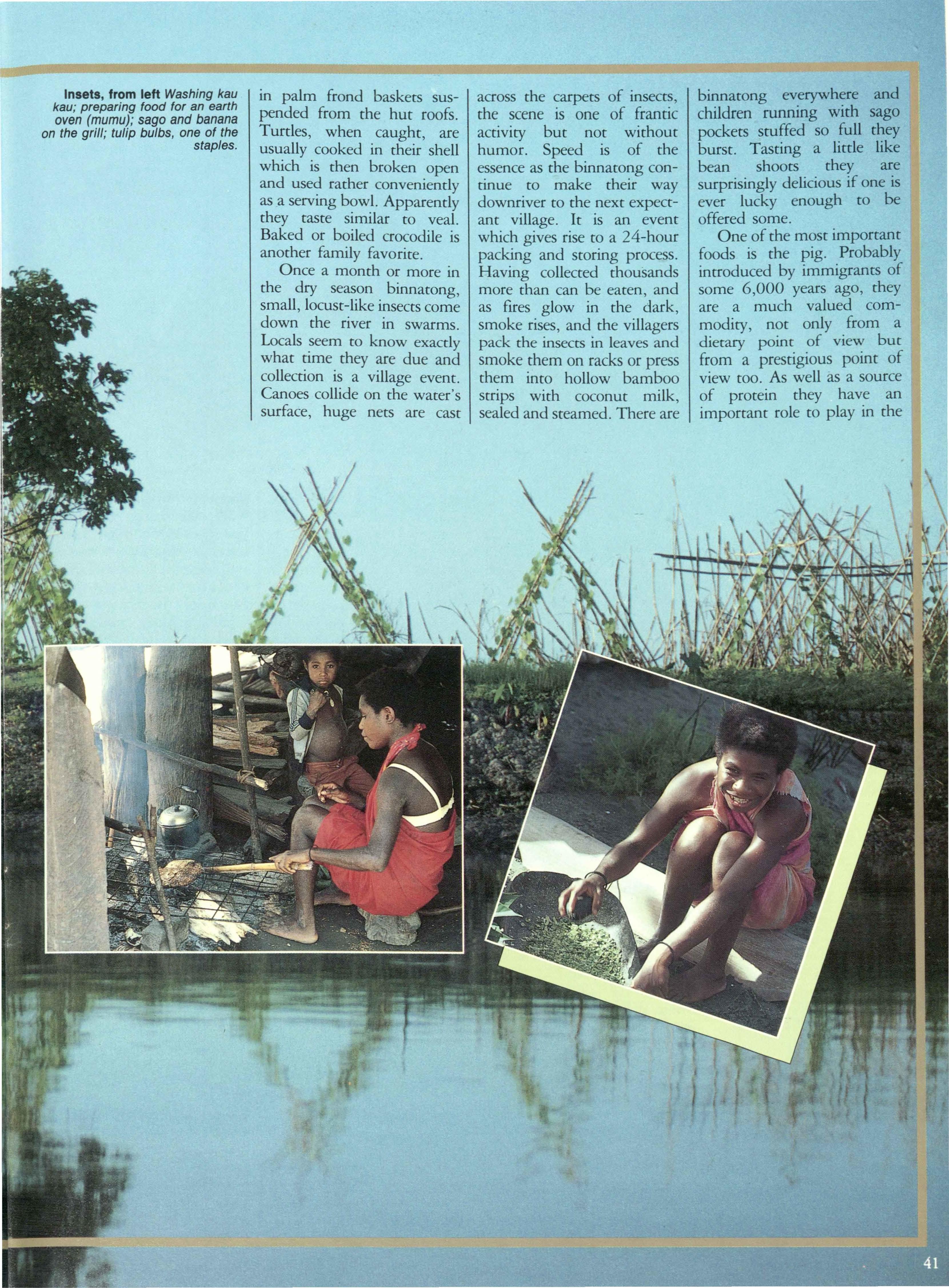
in palm frond baskets suspended from the hut roofs. Turtles, when caught, are usually cooked in their shell which is then broken open and used rather conveniently as a serving bowl. Apparently they taste similar to veal. Baked or boiled crocodile is another family favorite.
Once a month or more in the dry season binnatong, small, locust-like insects come down the river in swarms. Locals seem to know exactly what time they are due and collection is a village event. Canoes collide on the water's surface, huge nets are cast
across the carpets of insects, the scene is one of frantic act1v1ty but not without humor. Speed is of the essence as the binnatong continue to make their way downriver to the next expectant village. It is an event which gives rise to a 24-hour packing and storing process. Having collected thousands more than can be eaten, and as fires glow in the dark, smoke rises, and the villagers pack the insects in leaves and smoke them on racks or press them into hollow bamboo strips with coconut milk, sealed and steamed. There are
binnacong everywhere and children running with sago pockets scuffed so full they burst. Tasting a little like bean shoots they are surprisingly delicious if one is ever lucky enough to be offered some.
One of the most important foods is the pig. Probably introduced by immigrants of some 6,000 years ago, they are a much valued commodity, not only from a dietary point of view but from a prestigious point of view too. As well as a source of protein they have an important role to play in the
social, economic and religious system in many Papua New Guinean communities. Used traditionally to buy wives and pay debts and fines, their ownership is a measure of wealth and social status. It has been noted by anthropologists that the pig in fact is sometimes treated as part of the family, to the extent that orphaned piglets have been known to suckle at a mother's breast. Assuming they do not become too much part of the family they are most often killed for feasts and ceremonial purposes, cut up and boiled or roasted. Flying fox, another delicacy, is cooked on an open fire, a method which gets rid of the fur at the same time.
Small gardens, set up by men and most commonly cared for by the women, provide a source of fresh fruit and vegetables. Seasonal variation affects crops and garden
produce but in most areas there are reasonable supplies. Bananas, paw paw, watermelons and bright pink jamalacs are often taken into the towns and sold at the local market to provide a moderate income for some of the villagers. Taro, one of the most common garden crops is ready for harvesting after about 18 months. Baked, steamed and boiled, it, along with kaukau and sweet potato, is one of the three most common Sepik root vegetables. Weighing up to five kilograms they are carried in huge bilum bags by tiny, wiry women from the gardens to the villages.
Yam gardens, unlike the others are out of bounds to women and uninitiated men. Yam, :;1. crop commanding great respect and symbolism is the object of several food and sex taboos, as are several foodstuffs. These taboos are observed by the growers for the seven months between planting and harvesting. Yam festivals, a yearly event, venerate the crop as a life-giving force and are a time of celebration. Less exotic perhaps, swamp cabbage is one of the principal greens on the Sepik along with spinach, taro and paw paw leaves and various beans. Many of these, as well as fish and even sago,

are cooked with coconut milk while the water from very young coconuts is used as a refreshing drink. Collection and preparation of food is a protraaed affair. Much of the day is spent tending gardens, transporting food, washing sago and, finally, cooking and eating. Days are spent attending to survival, making sure there is a roof over one's head and enough food. Though there are occasionally large and communal ceremonies, most Sepik eating is done alone. If there is more food than one can eat it is left on the fire until someone is hungry. There does not appear to be particular meal times, food is for when hunger calls. In most areas of PNG food involves continuous labor to ensure adequate production. Tinned fish and rice from the increasing number of local stores provide an alternative and often a replacement to traditional food but they do not measure up to a few steamed locusts, lightly fried paw paw leaves or a bit of smoked cassowary. If one floats down the winding Sepik River in an old dugout canoe, do not be fooled. Supermarkets and delicatessens are absent but exciting cuisine lies in wait for the open minded.

Set in ten acres of tropical gardens, the Islander is located midway between the airport and the city centre, within 5 minutes drive of Central Government Offices, Parliament House and the National Museum.
Facilities include:
• 186 deluxe rooms and suites
• Direct-dial telephones with computer modems
• Colour TV and in-house video
• Complete secretarial services
• Conference and banquetting facilities for up to 500 people
• Travel agency
• Florist
• Hire car service
• Hairdressing salon
• Boutique
• News agency
• Coffee shop
• Restaurant
• Cocktail bar
•Nightclub
• 4 glass backed squash courts
• 2 synthetic grass tennis courts
• Fully equipped gymnasium
• Swimming pool
• Complimentary airport transfers The location is only one reason you will choose the Islander. The luxurious accommodations together with the superb cuisine, whether it be from our Kofi Haus Coffee Shop, from the elegant Sanamarie
A 'La Carte restaurant, or from our 24 hour room service, and the professional service from our courteous staff are all reasons why the Islander is Papua New Guinea's only truly International Hotel. The Pacific has great hotels . .. the Islander is the great hotel of the Pacific.
